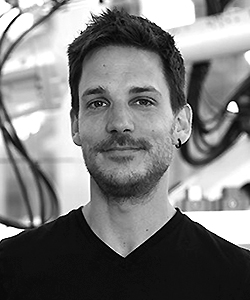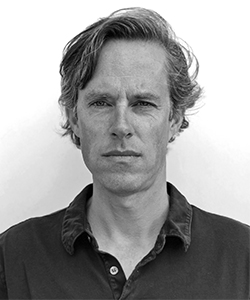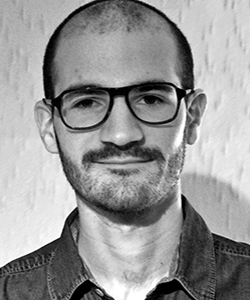Speakers

Robert Aish
Robert Aish is Visiting Professor of Design Computation at the Bartlett School of Architecture, where his research into the use of non-manifold topology to represent architectural space is supported by the Leverhulme Trust. Previously he was Director of Research at Bentley where he led the development of GenerativeComponents and Director of Software Development at Autodesk where he led the development of DesignScript. He is also a cofounder of the SmartGeometry group. He studied Industrial Design at the Royal College of Art and has a PhD in Human Computer Interaction from the University of Essex.
presenting: Robert Aish, Wassim Jabi, Simon Lannon, Nicholas Mario Wardhana & Aikaterini Chatzivasileiadi: Topologic: Tools to explore Architectural Topology

Guy Austern
Guy Austern is an architect and a PhD. candidate at the Technion, Israeli Institute of Technology. He has bachelor’s degree in both architecture and computer science and his research bridges between the two disciplines. As an architect, Guy has been involved in large scale projects for NCArchitects and SOM. He is also a programmer with years of experience in architectural coding and worked as a parametric specialist in robotic fabrication start-ups such as Robofold and Beyon3D. As a teacher, Guy has led design-build studios and taught courses about scripting, parametric design and digital fabrication.
presenting: Guy Austern, Gershon Elber, Isaac Guedi Capeluto & Yasha Jacob Grobman: Adapting architectural form to digital fabrication constraints

Phil Ayres
Phil is an architect, researcher and educator. He is Associate Professor at CITA, which he joined in 2009 after a decade of teaching and research at the Bartlett, UCL. His research focus is on adaptive systems that couple technical & organic systems, together with the development of complimentary design environments. This is currently pursued through the EU funded project flora robotica of which Phil is a Principle Investigator. Phil’s teaching roles are focused at Masters and PhD level and he is also the editor of the title Persistent Modelling – extending the role of architectural representation published by Routledge.
presenting: Phil Ayres, Alison Grace Martin & Mateusz Zwierzycki: Beyond the Basket Case: a principled approach to the modelling of kagome weave patterns for the fabrication of interlaced lattice structures using straight strips

Mathias Bernhard
Mathias Bernhard is a senior researcher at the Digital Building Technologies Group DBT, ETH Zurich. His primary interest lies in the development of computational design methods, the encoding and decoding of geometry, that allow to fully explore the potential of additive manufacturing in architecture. Mathias Bernhard studied architecture at the EPF Lausanne and the ETH Zurich, then specialized in computational design, digital fabrication and information technology while researching and teaching at the chair for Computer Aided Architectural Design CAAD, ETH Zurich. He holds a Master of Advanced Studies MAS in CAAD and is currently working on his doctoral dissertation.
presenting: Mathias Bernhard, Michael Hansmeyer & Benjamin Dillenburger: Volumetric Modelling for 3D Printed Architecture

Yu-Chou Chiang
Yu-Chou Chiang is a PhD candidate at Faculty of Architecture, TU Delft investigating the interrelation between structural design, funicular form-finding, and robotic construction. Having an engineering background, he worked as an educator and a researcher in the Department of Civil Engineering, National Taiwan University and as a structural engineer in several firms. In 2017, he started the PhD research on free-form construction and programmable materials, aiming to make the design and fabrication of elegant forms more efficient.
presenting: Yu-Chou Chiang, Sina Mostafavi & Henriette Bier: Assembly of Shells with Bi‐Stable Mechanism

Eftihis Efthimiou
A biologist and a designer, with a biology diploma from BaT, UoI, Ioannina and a M.Arch GAD from the Faculty of Architecture, UTh, Volos. He is researching the application of systems theory on design, and the implementation of autopoetic design strategies in digital fabrication. He is a core member of Decode Fab Lab in Athens, head of computational design. He is also a Lecturer at Exp.Arch, Fakultat fur Architektur, UIbk, Austria, and a Sc. Collaborator at the Advanced Design GAD, Faculty of Architecture, AUTh, Greece. He is fascinated by any design endeavor, be it an architectural project, an installation, or a graphic novel.
presenting: Eftihis Efthimiou: Liquid rock – Agent based modeling for concrete printing

Shohei Furuichi
Shohei Furuichi is a Teaching Associate at the Department of Architecture at the University of Tokyo since 2016. He received the Bachelor of Engineering and the Master of Engineering, in 2011 and 2013, respectively, both from the University of Tokyo. In 2012 He received the Excellent Presentation Award for Young Researchers from the Committee of Shell and Spatial Structures, the Architectural Institute of Japan. He is also a structural engineer, a principal member of Jun Sato Structural Engineers Co. Ltd. His research interests include the analysis of nonlinear phenomenon and its application to structural design.
presenting: Shohei Furuichi, Shuntaro Nozawa, Machiko Asahara, Priya Murugeswaran, Yuqing Shi, Ziyi Wu, Yusuke Obuchi & Jun Sato: Using Non-Linear Logic for Construction of Self-Stabilizing Hammock Structure

Yuqiong Lin
Post-graduate student in Architectural Design and Theory, CAUP, Tongji University; Bachelor of Architecture, Beijing University of Technology; Research focuses on wind tunnel based architectural morphology generation method. Some papers based on the research are already published in some conferences and journals such as Proceedings of CAADRIA 2018 [C], South Architecture [J], Housing Science [J], The International Journal of High Rise Buildings (IJHRB) [J] and so on. One of the tutors in CAADRIA 2018 International Workshop; Teaching assistant in DigitalFUTURES 2018 International Workshop “Pneumatic Wearables” and DigitalFUTURES 2017 International Workshop “Wind Tunnel Visualizaion”.
presenting: Yuqiong Lin, Jiawei Yao, Jingyun Zheng & Philip F. Yuan: Environmental-Performance Morphology Generation: Combining Physical Wind Tunnel and Dynamic Building Model

Alison Grace Martin
Weaver, independent researcher. Studies weaving techniques – principles of pattern, tension and repetition. Aiming to push expectations of traditional fibre work in order to expose relationships with complex surface visualization and structural morphology. Believes that the necessarily slow and painstaking process of hand-building physical models allows unexpected connections to be made and provides tactile understanding and practical insights into spatial concepts.
presenting: Phil Ayres, Alison Grace Martin & Mateusz Zwierzycki: Beyond the Basket Case: a principled approach to the modelling of kagome weave patterns for the fabrication of interlaced lattice structures using straight strips

Luke Ogrydziak
Luke Ogrydziak is a principal of OPA, an idea-driven architectural studio committed to finding design solutions that both expand the discipline and resonate within their particular context. Shaping and choreographing spatial experiences through the consideration of movement and formal logic results in work that is distinctive for its conceptual clarity and physical presence. OPA has been internationally published and exhibited for both built projects and research work. Luke Ogrydziak received BA and M. Arch degrees from Princeton University and has taught at Harvard University and the University of California, Berkeley.
presenting: Luke Ogrydziak & Zoë Prillinger: Nuclear Thresholds: Geometric Strategies for Flexible Cord Assemblies

Romain Mesnil
Romain Mesnil is a structural engineer and researcher specialized in constructive geometry and structural design. He is currently managing the co-innovation lab of l’Ecole des Ponts ParisTech, and its collaborative platform on digital fabrication for architecture. Research at the co-innovation lab lies at the intersection of structural design, material science and robotics, with special focus on 3D printing of concrete and geopolymers, complex timber structures and in-situ robotics.
presenting: Romain Mesnil, Douthe Cyril, Tristan Gobin & Olivier Baverel: Form Finding and Design of a Timber Shell-Nexorade Hybrid

Robin Oval
Robin is a structural engineer focusing on computational design and is currently pursuing a joint PhD with Prof. Dr. Olivier Baverel at the Navier Lab in École des Ponts ParisTech and with Prof. Dr. Philippe Block at the Block Research Group in ETH Zürich on topology finding of patterns for shell-like structures.
presenting: Robin Oval, Matthias Rippmann, Romain Mesnil, Tom Van Mele, Olivier Baverel & Philippe Block: Topology Finding of Structural Patterns

Davide Pellis
Davide Pellis is a PhD candidate at the department of Applied Geometry at Vienna University of Technology. He received the Master of Building Engineering in 2014 at University of Florence. After his studies, he started a PhD research in computational design and architectural geometry, with a focus on statics and optimization of free-form structures.
presenting: Davide Pellis & Helmut Pottmann: Aligning principal stress and curvature directions

Stefana Parascho
Stefana Parascho is a PhD researcher at Gramazio Kohler Research, as part of the National Centre of Competence in Research (NCCR) Digital Fabrication at ETH Zurich. She received her architecture degree from the University of Stuttgart and has worked for Knippers Helbig Advanced Engineering and Design-to-Production Stuttgart. After her studies, she has taught and researched at the University of Stuttgart, Institute of Building Structures and Structural Design and at ETH Zurich, Gramazio Kohler Research. Her current research focus lies in the development of multi-robotic assembly processes for architectural applications and integrative design methods for the design of robotically fabricated structures.
presenting: Stefana Parascho, Thomas Kohlhammer, Stelian Coros, Fabio Gramazio & Matthias Kohler: Computational Design of Robotically Assembled Spatial Structures

Mark Pauly
Mark Pauly joined EPFL in 2009 and is currently full professor at the School of Computer and Communication Sciences. He received his PhD in 2003 from ETH Zurich, spent two years as a postdoctoral scholar at Stanford University and four years as assistant professor at ETH Zurich. His research interests include computer graphics, geometry processing, computational design, digital fabrication, and architectural geometry. He received the ETH medal for outstanding dissertation in 2003, the Eurographics Young Researcher Award in 2006, an ERC starting grant in 2010, and the Eurographics Outstanding Technical Contributions Award in 2016.
presenting: Mina Konakovic Lukovic, Mark Pauly & Pavle Konakovic: Computational Design of Deployable Auxetic Shells

Goswin Rothenthal
Goswin Rothenthal studied architecture at Vienna University of Technology. He worked six years at Zaha Hadid Architects in London where he developed advanced computational and parametric design tools for completion and construction projects. He has been giving lectures at Architectural Association, Royal College of Art, Southbank University (London) , École Spéciale d’Architecture( Paris), University of Applied Arts and Vienna University of Technology . In the recent six years he worked at the Façade group of Waagner-Biro Stahlbau AG a technology leader in the construction of steel and glass building envelopes. He is researching and implementing computational design tools and workflows to tightly integrate the design and manufacturing process in an automated way on large scale construction projects such as the Louvre Abu Dhabi Dome.
presenting: Goswin Rothenthal, René Ziegler & Djordje Spasic: Oasis of Light – Manufacturing the Cladding of the Louvre Abu Dhabi

Eike Schling
Since 2007, Eike Schling had worked as an Architect for Auer+Weber+Associates and Donath Bickel Architects in Munich before moving to London in 2009. Here, he was engaged with PLP Architecture and was responsible for the computational design of large-scale projects such as One Bishopsgate Plaza and the Francis Crick Institute, for which he was awarded 1st prize for its parametric design at the Bentley BE Inspired Awards 2011. Since 2012 Eike has been working for the Chair of Structural Design at the Technical University Munich investigating the geometric behavior of curved support structures.
presenting: Eike Schling, Martin Kilian, Hui Wang, Jonas Schikore & Helmut Pottmann: Design and construction of curved support structures with repetitive parameters

Xavier Tellier
Xavier Tellier is a structural engineer and PhD candidate at the Laboratoire Navier at Ecole des Ponts ParisTech. His doctoral research focuses on fabrication-aware design of free-form architectural envelopes. He has an engineering diploma from Ecole Polytechnique in France. He worked as a project engineer for COWI North America, where he was in charge of the geometry control of the Oculus Transportation Hub in New York during its construction phase. He also worked at Leicht Structures where he designed non-standard facade structures.
presenting: Xavier Tellier, Laurent Hauswirth, Cyril Douthe & Olivier Baverel: Discrete CMC surfaces for doubly-curved building envelopes

Christopher Williams
Chris Williams is an Artistic Professor at Chalmers University. Chris joined Ted Happold’s group at Arup in 1972 where he worked on Frei Otto’s Multihalle gridshell in Mannheim. His research interests hinge on the relationship between geometry and structural action as applied to towers, bridges and fabric and shell structures. His work in the generation of structural form through biological and other analogies has led to collaboration on projects including the British Museum Great Court Roof, the Savill Building, the Gardens by the Bay glasshouses and the Netherlands Maritime Museum. His work on these projects involved writing project specific software for geometry definition and structural analysis.
presenting: Emil Adiels, Mats Ander, Erica Hörteborn, Jens Olsson, Karl-Gunnar Olsson, Alexander Sehlström, Paul Shepherd & Christopher Williams: The use of virtual work for the formfinding of fabric, shell and gridshell structures

René Ziegler
René Ziegler studied structural engineering at the Universität Karlsruhe (TH). This was followed by research and teaching at the Institute of Structural Mechanics focusing on computational mechanics and their application on lightweight structures. The interest in architecture led to Waagner-Biro Stahlbau AG, a technology leader in the construction of steel and glass building envelopes. He is currently the head of the structural design department and furthermore contributes to the research and development activities of the building envelope division. These activities encompass advances in geometric and structural design as well as the investigation of future construction methodologies.
presenting: Goswin Rothenthal, René Ziegler & Djordje Spasic: Oasis of Light – Manufacturing the Cladding of the Louvre Abu Dhabi
